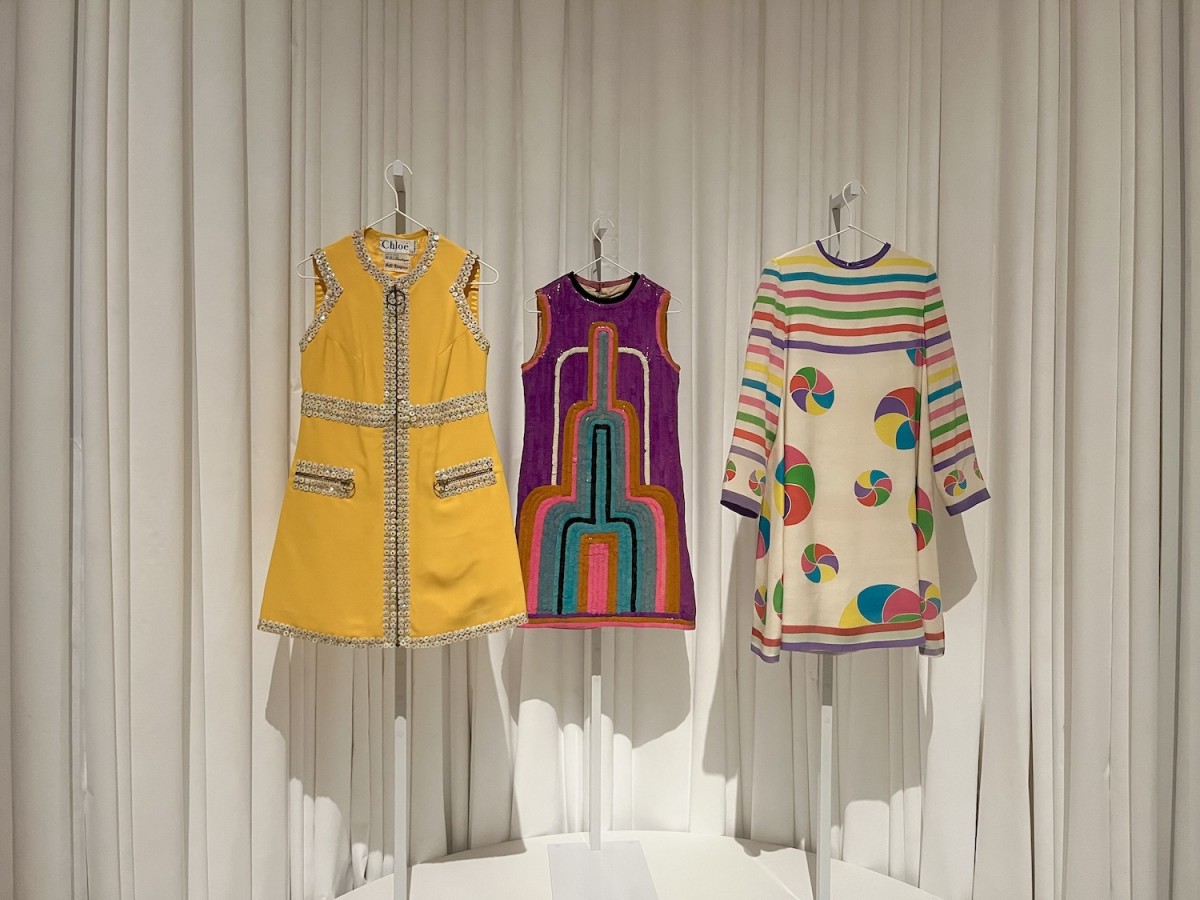With banana hands holding up boobs, shrimp-printed jeans, dress-patterned dresses and hand-painted gowns, “Mood of the moment: Gaby Aghion and the house of Chloé” is the museum show to see. The Jewish Museum’s current exhibition chronicles the house of Chloé’s history, and will remain open through Feb. 18.
The show, curated by Claudia Gould, Choghakate Kazarian and Kristina Parsons, brings viewers through different eras of the fashion house’s history. On the walls, covered mostly in white creped fabric, archival design documents and over 100 items of clothing are showcased, highlighting the big-name fashion icons who have directed the company over time.
The founder of Chloé, Gaby Aghion was originally from Alexandria, Egypt. Her family, like many others in the Egyptian-Jewish community in the early 20th century, appreciated French culture from afar by picking up the language and Parisian sense of style. She moved to Paris in 1945 and started her fashion brand in 1952, after having been immersed in French fashion for her entire life.
“I started Chloé because I loved the idea of couture, but found the concept a little out of date — a little artificial. A thing of beauty and quality should be seen on women in the streets,” reads an Aghion quote painted on the archway of the exhibition’s entrance, leading viewers into the world of Chloé.
The exhibition was designed by architect and interior designer Elliott Barnes, and it follows the work of each of Chloé’s creative directors chronologically, on a clearly laid circular path from room to room. Viewers begin in the early days of the brand, with the walls plastered in black-and-white images of Aghion, transitioning from Egypt to Paris and accompanied by a detailed timeline. Nearby mannequins feature Aghion’s early designs.
The beginnings of the company are most defined by the work of a young Karl Lagerfeld, who is known best for his later time at Chanel. Aghion hired Lagerfeld to design with her in 1964, and he became Chloé’s sole designer in 1975. As such, his work takes up most of the early spaces in the exhibition.
The wall text of the exhibition points out an important piece of history that cannot be overlooked, especially within the context of the museum — Lagerfeld’s parents were members of the Nazi Party. He attempted to hide this fact from the public, and still managed to maintain a close relationship with Aghion despite it.
From neutral ruffled gowns, to logo T-shirts paired with black lace maxi skirts, to bright dresses adorned with sequins and glass, Lagerfeld’s work covers a wide range. The work gets more fun but equally as sophisticated toward the end of his time designing for the company. This is especially highlighted by a cerulean blue 1983 dress, which has two silver sequin water faucets on each side, pouring a stream of sequins, beads and crystals down the back of the dress.
“With each collection, I tried to crystallize the mood of the moment,” Lagerfeld said during his time as Chloé’s designer.
Visitors then move through the ’80s, reaching the start of Martine Sitbon’s reign. This was an era of Chloé categorized by glamorous Parisian gowns and suits, and a reference to Lagerfeld’s earlier work. What’s most exciting, though, is what comes after this era — the “Young British Women Designers” section. The wall text states that “in 1997 Chloé returned to Aghion’s original vision: women dressing women,” and these female fashion designers surely packed a punch at the house.
The section features a T-shirt that says “KEEP YOUR BANANAS OFF MY MELONS,” A-line dresses with rose gold sequined horse heads, military-cut neutral blouses, a bulky multi-color coat made of hand-knotted yarn and much more. Designers and artistic directors Stella McCartney, Phoebe Philo, Hannah MacGibbon and Clare Waight Keller each brought their own artistic flair to the house, while finding a way to, as the wall text reads, “revive and reinterpret Chloé’s bohemian styles.”
The exhibition comes to a serendipitous close in its last two sections. “Vintage in the Future” shows the work of the brand’s two most recent creative directors, Natacha Ramsay-Levi and Gabriela Hearst, who both turned back to some of Chloé’s older moments for inspiration by referencing past bohemian motifs and some of Lagerfeld’s geometric patterns.
Lastly, we return back to our starting place — Alexandria. Through blouses from the decades that exemplify “The Colors of Egypt” such as beiges, whites and dusty roses, we are brought back to Aghion’s roots, underscoring how Chloé — though changed over time — will always be grounded by its founder’s vision.
While jam-packed with information and clothing, the exhibition was easy and fun to explore, with a layout as beautiful as the art itself.
The Jewish Museum is housed in the Gothic Revival-style Warburg Mansion on the Upper East Side’s Museum Mile. The building’s ornate architecture is a sight to see in and of itself, but Barnes designed the space so that the clothes — placed on simple clothing hangers and mannequins over the white fabric-covered walls — could stand on their own.
The ability for viewers to learn from these fashion visionaries by inspecting some of their sketches, along with the access viewers get to watch exclusive runway shows through TV footage on the walls allowed for in-depth insight into Chloé’s ethos. The museum space was used in a way that made this laser-focused history easy to digest, with a clear understanding of its historical timeline.
“Mood of the moment” highlighted the way that the Jewish visionary’s brand blossomed and grew as it changed hands among the most revered names in fashion. This exhibition may be not only the most educational, but also the best overall, that I have ever seen.
Contact Alexa Donovan at [email protected].

























































































































































Mary Wade • Nov 13, 2023 at 9:57 pm
Excellent review. Makes me want to see the exhibit! Thanks.